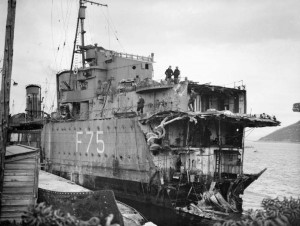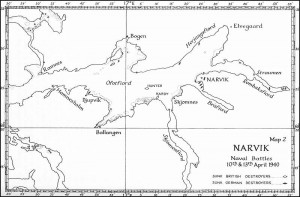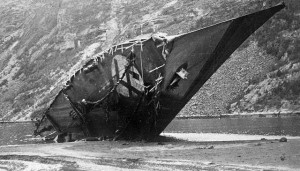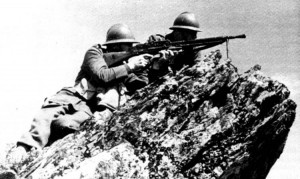 When discussing the battle of Narvik, history is referring to two separate battles that were fought between the 9th of April and the 8th of June in 1940. The battles comprised of a naval battle and an air battle in the Norwegian city of Narvik. The battles of Narvik were part of the campaign in World War II known as the Norwegian Campaign.
When discussing the battle of Narvik, history is referring to two separate battles that were fought between the 9th of April and the 8th of June in 1940. The battles comprised of a naval battle and an air battle in the Norwegian city of Narvik. The battles of Narvik were part of the campaign in World War II known as the Norwegian Campaign.
The city of Narvik was used for the transportation of iron ore from Sweden as the harbor was ice free. The supply of iron ore was very important to both sides in the war, with the interest sparking one of the largest scale battles fought in World War II. Britain had considered Narvik as a landing point for an expedition to aid Finland in the winter war, the opportunity also being seen as a way to take control of the mines of the Swedish.
First Battle of Narvik
The first battle of Narvik consisted of a naval battle that was fought between German and British destroyers during the invasion of Norway by Germany. On the 9th of April, all of Norway’s 6 ports had been attacked by Germany, Narvik being the port in the northernmost position. Narvik was a remote port and was attacked by a small army, but it was important to the Germans because of its supply of iron ore.
Location of Narvik
 Narvik is located to the east of Oftfjord, one of five fjords that run off Ofotfjord. The ten German destroyers that captured Narvik split up and went towards the other fjords in three groups. All ten of the German destroyers were large destroyers, and they would be attacked by five British destroyers under Warburton-Lee. His ships were smaller than the German counterparts, and by the time he reached Tranoy on the 9th of April, he was aware of the German presence at Narvik.
Narvik is located to the east of Oftfjord, one of five fjords that run off Ofotfjord. The ten German destroyers that captured Narvik split up and went towards the other fjords in three groups. All ten of the German destroyers were large destroyers, and they would be attacked by five British destroyers under Warburton-Lee. His ships were smaller than the German counterparts, and by the time he reached Tranoy on the 9th of April, he was aware of the German presence at Narvik.
Timely Arrival at Narvik
Even though he was warned that he would need more ships, Warburton-Lee continued his advance to Narvik. Arriving at 4 a.m. on April 10th, his fleet was hidden by snowstorms. At 4:30, he was able to lead three of his fleet into the harbor where he sank three German destroyers. He had sunk two and gone about disabling another three, but this still left five more undamaged destroyers.
Before being able to head back out to sea, three destroyers came from the west at around 6 a.m. The larger ships of the Germans put Britain at a disadvantage and with two more appearing from the west, the British were caught between two attacks. It was during these attacks that Warburton-lee lost his life and, in total, three British destroyers were damaged. Five German destroyers were badly damaged and two ships from the British fleet allowed for the rescue of a third. The only ship of the German’s to actually reach Narvik was sunk by the British on their way out.
Second Battle of Narvik
 The second battle of Narvik occurred just three days later, on the April 13, 1940, with the return of the British. This time they came with a much greater force of nine destroyers and the battleship HMS Warspite. The Germans also reinforced their fleet with an additional three destroyers, but they found that they were short on ammunition and fuel as well. As a result, they were at a disadvantage when the British launched their attack with Warspite.
The second battle of Narvik occurred just three days later, on the April 13, 1940, with the return of the British. This time they came with a much greater force of nine destroyers and the battleship HMS Warspite. The Germans also reinforced their fleet with an additional three destroyers, but they found that they were short on ammunition and fuel as well. As a result, they were at a disadvantage when the British launched their attack with Warspite.
British Advantage
With the HMS Warspite leading the British forces, they had a clear advantage that increased with the launch of their aircraft, Swordfish. The battleship made its way into Ofot Fiord and headed for Narvik some thirty miles ahead, protected and screened on all sides by nine destroyers. At precisely 11:52 the aircraft was commissioned and ordered to bomb any suitable targets.
Low cloud made the perfect setting for the advantage of the British and Swordfish simply flew through the fjord as if it were progressing through a tunnel. The British destroyers opened fire on a German vessel that was sited to the west and the Swordfish dived to bomb a submarine. The submarine sank within less than a minute, but it had time to fire at Swordfish, making its controls sluggish for the rest of the flight.
12:40
 At 12:40 it was reported by Commander Brown that an enemy destroyer was hiding in a bay five miles ahead, hoping to remain unspotted and ready to open fire on the force that was advancing. Its destruction was complete in just a few minutes thanks to fire from Warspite and the leading destroyers’ torpedoes and guns.
At 12:40 it was reported by Commander Brown that an enemy destroyer was hiding in a bay five miles ahead, hoping to remain unspotted and ready to open fire on the force that was advancing. Its destruction was complete in just a few minutes thanks to fire from Warspite and the leading destroyers’ torpedoes and guns.
Shortly after this attack, Commander Brown spotted the tracks of five torpedoes that were approaching the force. With enough warning, they passed them by with the torpedoes exploding on the cliff edges of the fjord. The enemy destroyers retreated under the cover of the smoke with five British ships pursuing them; other ships entered into the harbor at the same time and another German destroyer was blown up.
Smoke was making vision very poor by this time, but the Warspite continued to engage with the enemy and the Swordfish reported two more destroyers of the enemy at the head of the fjord. With gunfire taking place between the enemy and the British destroyers, the Eskimo had her bow blown away and a German destroyer was finally run aground. The destroyer that was run aground was then bombed and finished off by the Swordfish.
Diminishing Ammunition
By 3:30, there were three remaining German destroyers lurking around and the British fleet was running low on ammunition. The British were determined to continue, even under the threat that of torpedo fire from the remaining German vessels, but continuing up the fjord, there was no response to their fire. It was discovered that the last three remaining vessels had indeed been abandoned by the Germans. These ships were quickly finished off by the British fleet, and it was reported that the victory by the British had been achieved with no losses to the British fleet.